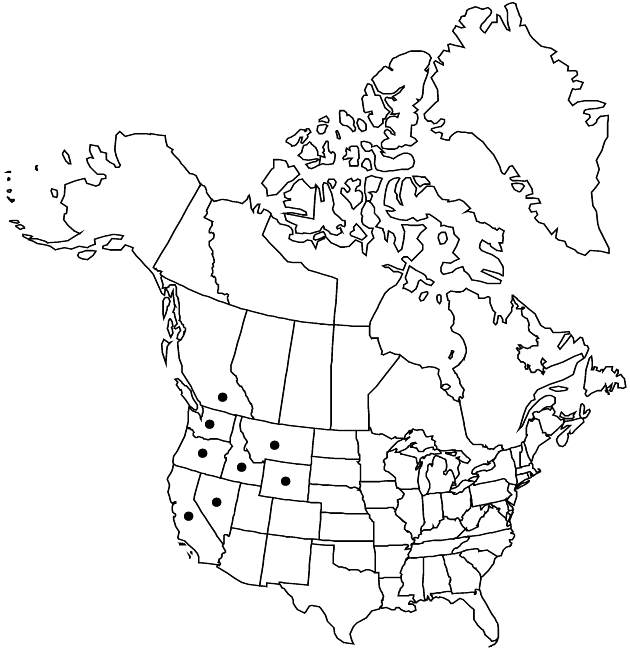Difference between revisions of "Pyrrocoma carthamoides"
Fl. Bor.-Amer. 1: 307, plate 107. 1803.
FNA>Volume Importer |
RevisionBot (talk | contribs) m (Bot: Adding category Revised Since Print) |
||
| (7 intermediate revisions by 3 users not shown) | |||
| Line 8: | Line 8: | ||
}} | }} | ||
|common_names=Large-flower goldenweed | |common_names=Large-flower goldenweed | ||
| + | |special_status={{Treatment/ID/Special_status | ||
| + | |code=E | ||
| + | |label=Endemic | ||
| + | }} | ||
|basionyms= | |basionyms= | ||
|synonyms={{Treatment/ID/Synonym | |synonyms={{Treatment/ID/Synonym | ||
|name=Haplopappus carthamoides | |name=Haplopappus carthamoides | ||
|authority=(Hooker) A. Gray | |authority=(Hooker) A. Gray | ||
| + | |rank=species | ||
}} | }} | ||
|hierarchy=Asteraceae;Asteraceae tribe Astereae;Pyrrocoma;Pyrrocoma carthamoides | |hierarchy=Asteraceae;Asteraceae tribe Astereae;Pyrrocoma;Pyrrocoma carthamoides | ||
| Line 23: | Line 28: | ||
-->{{Treatment/Body | -->{{Treatment/Body | ||
| − | |distribution= | + | |distribution=B.C.;Calif.;Idaho;Mont.;Nev.;Oreg.;Wash.;Wyo. |
|discussion=<p>Varieties 3 (3 in the flora).</p><!-- | |discussion=<p>Varieties 3 (3 in the flora).</p><!-- | ||
--><p><i>Pyrrocoma carthamoides</i> is recognized by its erect, leafy, and villous stems, hispidulous leaves and phyllaries, and large, usually single heads with somewhat loose phyllaries. The ray florets are usually reduced but sometimes are lacking altogether.</p> | --><p><i>Pyrrocoma carthamoides</i> is recognized by its erect, leafy, and villous stems, hispidulous leaves and phyllaries, and large, usually single heads with somewhat loose phyllaries. The ray florets are usually reduced but sometimes are lacking altogether.</p> | ||
| Line 56: | Line 61: | ||
-->{{#Taxon: | -->{{#Taxon: | ||
name=Pyrrocoma carthamoides | name=Pyrrocoma carthamoides | ||
| − | |||
|authority=Hooker | |authority=Hooker | ||
|rank=species | |rank=species | ||
| Line 63: | Line 67: | ||
|basionyms= | |basionyms= | ||
|family=Asteraceae | |family=Asteraceae | ||
| − | |distribution= | + | |distribution=B.C.;Calif.;Idaho;Mont.;Nev.;Oreg.;Wash.;Wyo. |
|reference=None | |reference=None | ||
|publication title=Fl. Bor.-Amer. | |publication title=Fl. Bor.-Amer. | ||
|publication year=1803 | |publication year=1803 | ||
| − | |special status= | + | |special status=Endemic |
| − | |source xml=https:// | + | |source xml=https://bitbucket.org/aafc-mbb/fna-data-curation/src/2e0870ddd59836b60bcf96646a41e87ea5a5943a/coarse_grained_fna_xml/V19-20-21/V20_948.xml |
|tribe=Asteraceae tribe Astereae | |tribe=Asteraceae tribe Astereae | ||
|genus=Pyrrocoma | |genus=Pyrrocoma | ||
| Line 74: | Line 78: | ||
}}<!-- | }}<!-- | ||
| − | -->[[Category:Treatment]][[Category:Pyrrocoma]] | + | --> |
| + | |||
| + | [[Category:Treatment]] | ||
| + | [[Category:Pyrrocoma]] | ||
| + | [[Category:Revised Since Print]] | ||
Latest revision as of 18:25, 6 November 2020
Plants 5–50 cm. Stems 1–4, erect or ascending to decumbent, reddish, leafy, villous. Leaves: basal (in rosettes) petiolate, blades lanceolate to oblanceolate or spatulate, 50–200 × 5–40 mm, margins usually spinulose-serrate, sometimes entire, ciliate, apices acute, faces puberulent; cauline sessile, blades linear-lanceolate, 40–100 × 5–15 mm, reduced distally, faces glabrous or villous-hispid, eglandular. Heads usually borne singly, terminal, sometimes 2–3 in racemiform arrays, subtended by leaflike bracts. Peduncles 1–5 cm. Involucres turbinate to campanulate, 10–20 × 15–35 mm. Phyllaries in 3–5 series (± loose), linear-lanceolate to oblong, 10–20 mm, unequal, bases tapering, margins spinulose-serrate, ciliate, apices occasionally recurved, acute, mucronate, faces puberulent. Ray florets 0 or 1–30; corollas yellow, 2–7 mm (not surpassing involucres). Disc florets 25–50; corollas 9–14 mm. Cypselae subcylindric, 3–5.5 mm, 4-angled, faces striate or smooth, glabrous; pappi tawny, 6–9 mm.
Distribution

B.C., Calif., Idaho, Mont., Nev., Oreg., Wash., Wyo.
Discussion
Varieties 3 (3 in the flora).
Pyrrocoma carthamoides is recognized by its erect, leafy, and villous stems, hispidulous leaves and phyllaries, and large, usually single heads with somewhat loose phyllaries. The ray florets are usually reduced but sometimes are lacking altogether.
Selected References
None.
Lower Taxa
Key
| 1 | Phyllary apices broad, truncate, abruptly muc-ronate, mucro usually recurved | Pyrrocoma carthamoides var. subsquarrosa |
| 1 | Phyllary apices acute to acuminate, mucro erect | > 2 |
| 2 | Involucres hemispheric, 20–35 mm wide; phyllaries ± overlapping, broadly oblong to obovate | Pyrrocoma carthamoides var. carthamoides |
| 2 | Involucres campanulate or turbinate, 15–20 mm wide; phyllaries loose, scarcely overlap-ping, lanceolate | Pyrrocoma carthamoides var. cusickii |